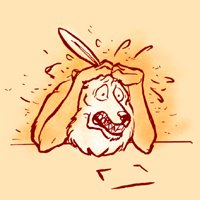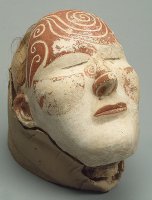 |
Grave goods |
A list of stuff found in the various graves. Eventually I hope to have good statistics on numbers of stuff, location, etc., but for now it's just a nice listing.
Clothing & jewelry
silk dresses
hat & outer coat (child's grave)
gold torque
colorful glass & stone beads (both large & small) and small gold beads
bracelets (the rich women had gold & turquoise ones from Kazakstan)
bronze spiral earrings covered with gold foil
"Religious significance"
arrowhead in leather pouch on leather thong necklace
an engraved boars' tooth pendant to hang on the belt
fossilized seashells, often with pastes in them: charcoal, chalk, brick-red, mustard yellow, blood-red cinnabar -- which are also the common colors of tattoos and clothing for the Sarmatians
carved bone spoons
small chunks of ochre, cinnabar, and chalk
carved stone altars or hearths (the Saka used bronze ornamentation around the edges, with small cast-bronze animal scenes, as well as bronze cauldrons)
Lots of aromatic burnable herbs, some psychoactive
sheep shoulderblades & anklebones for divining and/or gaming
ritual cup (or kubok)
"fake" spindle whorls made from chalk, which would not survive actual use -- symbolic?
"Everyday" stuff
mirrors, in almost every woman's grave: brass ones from the Han Dynasty, or bronze ones incised with rosettes & geometric motifs, or plain bronze circles
Spindle whorls or loom weights
lots of pottery -- incense cups, jugs holding animal offerings, mugs, etc.; usually the black glaze, but some really lovely Greek amphorae
gold-stamped perfume bottles from Greek craftsmen of the Bosporus
short "eating knife": no hilt, one edge, very short, usually iron
whetstone / flint
amulets in the Animal Style (usually snow leopard)
gold belt ornaments
Large carved wooden bowl (about 13" x 9"), from the 3rd to 4th century, currently located in the State Hermitage Museum. What were the partial holes for -- to anchor decorations maybe? To hang it?
Carved wooden scoop or spoon (about a foot long), from the 3rd to 4th century, currently located in the State Hermitage Museum. I can't tell how the handle is attached -- is that a tiny wooden peg visible on the inside?
Woman's death mask (slightly more than 9" long), made of gypsum with admixture and ochre; moulded and painted, from the 3rd to 4th century, currently located in the State Hermitage Museum. Very cool patterns -- what's their significance?
Tack
bronze horse bits
plaques (or phalerae) for (clan-distinctive?) bridles
textile appliqued saddle blankets & decorated girths
Weapons & armor
lots of double- and tri-lobed arrowheads: bronze, iron
long iron spearhead
long iron dagger or short sword (akinakes)
armor
bits of recurved bows & gorytus
Copyright © 1992-2025 B. "Collie" Collier. All rights reserved.
Web site design & maintenance: Laughing Collie Productions
Contact the web administrator for any technical problems


